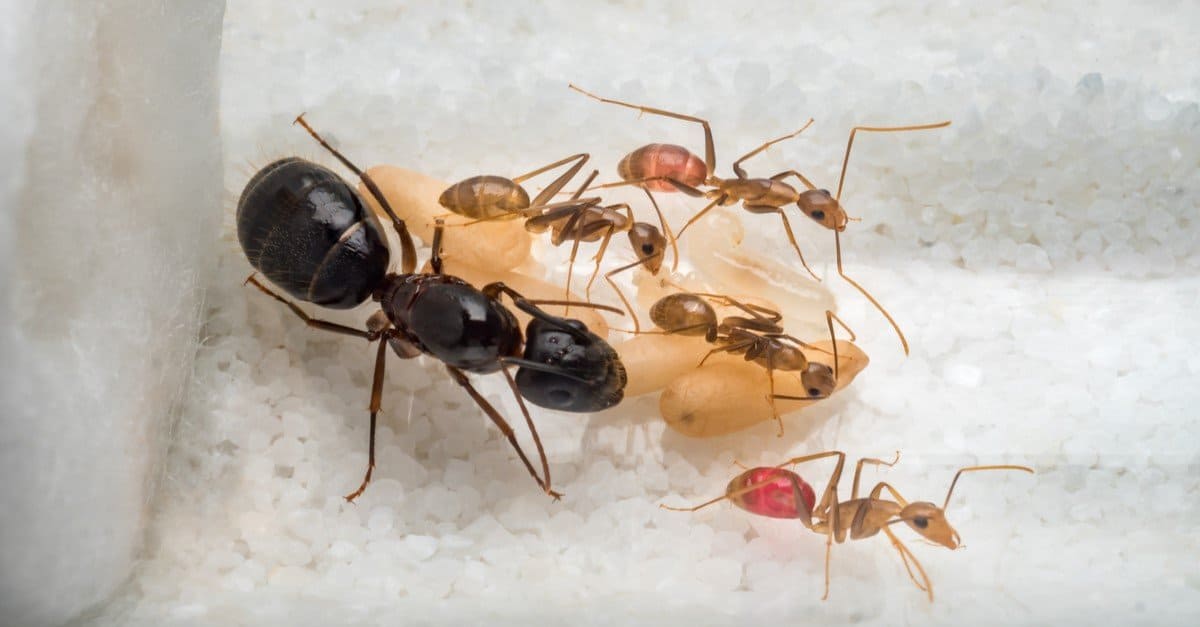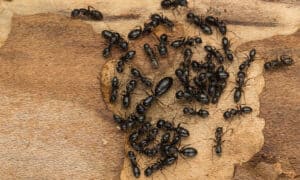If there’s anything ants do right, they can organize their colonies remarkably well. Watching ants in their colonies, you can’t help but admire the harmonious cooperation as each insect aptly goes about their business. As a result, they carry out their duties with resounding success. These eusocial insects are organizers par excellence.
Yet it is not about the organization so much as it is about the reproductive division of labor. Ant colonies have a caste system, where responsibilities are divided in a systemic hierarchical order.
As with human society, the typical ant hierarchy system comprises a queen, males, and workers with specific roles. But in contrast, there is no such thing as the king ant, as is mostly the case in human royal setups. So, it’s fair to ask: why is there no king ant?
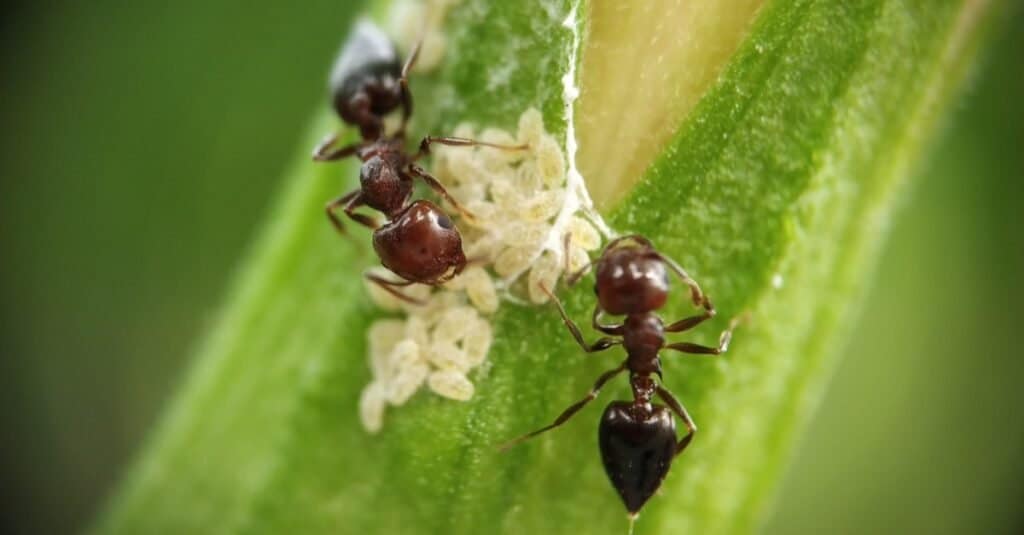
Ant colonies have a caste system, where responsibilities are divided in a systemic hierarchical order.
©IamBijayaKumar/Shutterstock.com
1. The Queen Ant Can Reproduce Without a Male
How can a female reproduce without male eggs, you ask? While ant species exist in thousands, most ants use the same strategy to secure the perpetuation of their kind. Typically, an ant colony is founded by the queen. The queen is the mother of all ants in the kingdom. The queen lays all the eggs that give rise to worker ants, soldier ants, male ants or drones, and female princess ants.
How Ants Reproduce
When virgin male ants and princesses grow up and mature, they will engage in nuptial flight. The nuptial flight is a mating ritual that usually occurs in warm and humid months with moderate rain, mostly during spring and summer. On this day, dozens of mature males and females fly out of the nests into the air to mate.
Often, female princess ants will mate with several males. So, the male ant is typically not the only one that produces the offspring of a colony, as is the case with the queen. The female ants collect the male egg cells in millions and store them in specialized pouches in their abdomens called the spermatheca.
These male eggs are enough to fertilize millions of the female’s eggs throughout her lifetime. Male reproductive cells can live for up to 20 years inside the spermatheca. Therefore, the males won’t be needed anymore after the mating. After that, the female princess ant will fly out and start her colony as the queen. The female will shed the wings she was born with and dig or find a chamber where to dwell in.
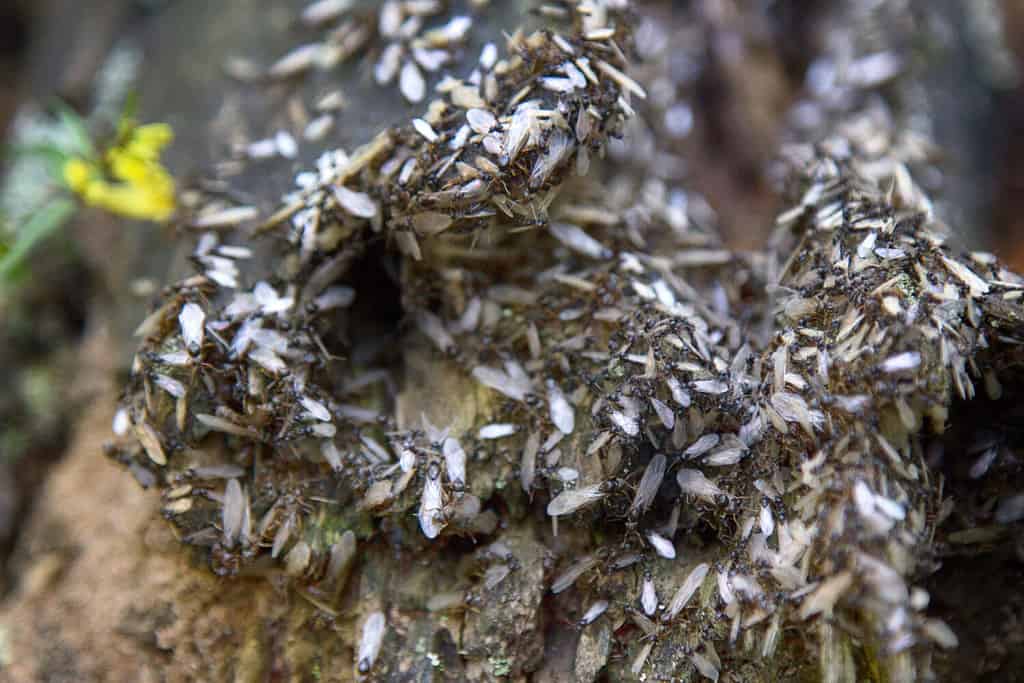
When virgin male ants and princesses grow up and mature, they will engage in nuptial flight.
©Maximillian cabinet/Shutterstock.com
Fun Fact: Did You Know the Queen Does Not Eat After Mating?
Ant queens do not eat after mating because their bodies undergo significant changes. Mating results in the release of hormones that induce the queen’s ovaries to produce eggs and her body to prepare for the role of a reproductive powerhouse for the rest of her life. This process makes the queen unable to eat solid food due to the drastic changes in her digestive system. Eating would waste the resources the queen needs to produce offspring and secure the colony’s survival. She relies on nutrients stored in her fat reserves for energy and sustenance.
The queen will use nutrients from her reserves until she’s brought up at least a half dozen ‘nanitics.’ Nanitics are tiny, weak, short-lived adult ants that are usually rushed so that they can care for and feed their mama before she starves to death.
2. Males Die Shortly After Mating

Male ants hardly survive longer than eight days after mating and may seem pretty unfair to the males.
©Andrey Pavlov/Shutterstock.com
Male ants hardly survive longer than eight days after mating and may seem pretty unfair to the males. After mating, males do not stick around long enough to be kings of the colony. They die 4 – 8 days after mating for the following reasons.
Genetics
Males only have half the number of chromosomes compared to females. Queen ants produce drones by laying unfertilized eggs. This process is known as haplodiploidy, a unique form of sex determination found in ants and other social insects. In haplodiploid organisms, males develop from unfertilized eggs, and females develop from fertilized eggs.
Due to the lack of diversity in their genes, males have a shorter lifespan.
Traumatic Copulation
Some male ants die after mating because their reproductive system explodes during copulation. The male ant’s genitals are specially designed to detach from its body, remain inside the queen’s reproductive tract, and burst open releasing a large amount of sperm. This traumatic process causes the male ant to die shortly after mating. This biological phenomenon is known as traumatic insemination. It is a common phenomenon observed in many other insects and arachnids.
Starvation
Since the drones have served their sole purpose in the reproductive cycle of the ant colony, their presence is no longer necessary. The workers will no longer give the drones proper ant food and nutrition like the queen. The male ant is thus deprived of his nutritional requirements and dies shortly after mating.
Males cannot Re-mate
Male ants produce a limited number of sperm due to the physical constraints of their reproductive system. Producing a large amount of sperm requires a lot of energy, and male ants are tiny and have limited resources to allocate to reproductive efforts. As a result, the male ants have evolved to produce a limited number of high-quality sperm, which means that they cannot re-mate.
3. Ant Colonies Do not Require a Ruler

Even though their title may indicate otherwise, queen ants are anything but dominant.
©iStock.com/ViniSouza128
Even though their title may indicate otherwise, queen ants are anything but dominant. The queen’s position as the colony’s founder gives them no sense of majesty and supremacy.
Human royal hierarchies have the king and queen to guide and govern their subjects, ensure their safety and well-being and act as symbols of leadership and power.
Often, the royal couples will lend each other a helping hand in matters of governance and leadership. However, ants seldom need governance. Neither do ants need a leader to direct them on what to do or make decisions.
How Do Ants Coordinate Their Operations?
Ants use pheromones to communicate with each other and organize themselves into efficient and coordinated societies. Pheromones are chemical signals ants produce that other ants can detect using their antennae.
The division of labor among the worker ants is complex and is based on factors such as age, size, and experience. However, the chemical signals help ants organize themselves without leadership and work together as a highly efficient and cooperative society.
And you must have already caught on to the fact that the queen can carry out her role of pumping out eggs without needing a male. So, the colony doesn’t need a king to lead them. Neither does a queen need a lifelong breeding partner.
4. Hostility From the Colony
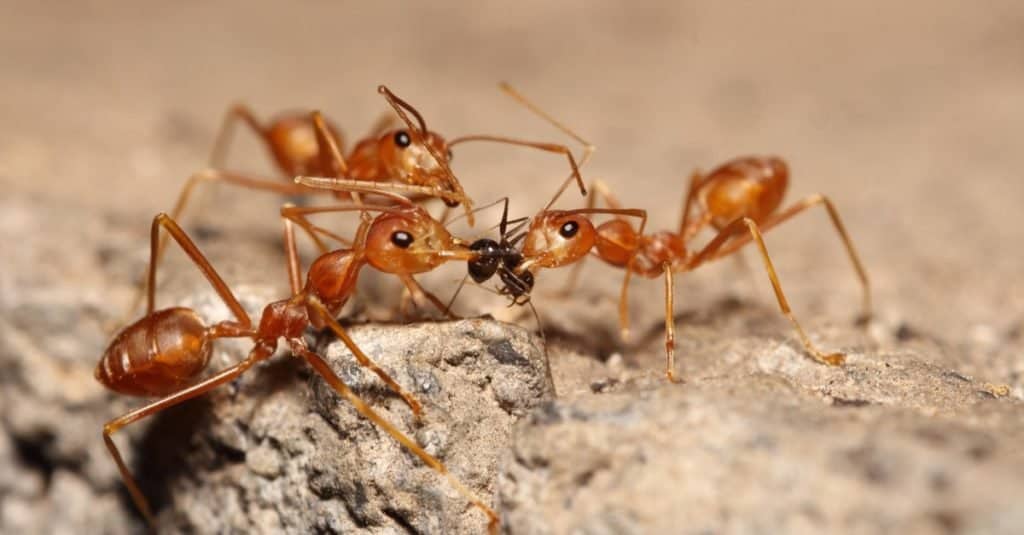
The workers of some ant species may chase away the male.
©sarawuth wannasathit/Shutterstock.com
Worker ants are usually not very accommodating to male ants in the nests after mating copulation. Worse yet, the workers of some ant species may chase away the male. The workers view the male ant as a potential threat to the colony’s survival since he consumes resources while contributing nothing to the colony’s productivity. Other ants work for the survival of the colony.
Therefore, the worker will kick out the male ant from the nest to ensure the continued success and survival of the colony. Consequently, a male ant does not live in the nest long enough post-mating to be crowned king.
5. Having No King Is Efficient and Economical

Producing new male offspring is more efficient and economical than feeding the old males without any purpose
©iStock.com/_jure
Ants have withstood multiple extinction events, including the ice age. For one reason, they are highly adaptable. The other reason is that royal bugs have evolved to keep the male around for as long as needed, only to save resources.
Male ants do not contribute to the colony’s productivity and only serve to mate with the queen. Yet again, these males can be reproduced quickly and easily since they only have half the number of chromosomes compared to females. Therefore, producing new male offspring is more efficient and economical than feeding the old males without any purpose. That said, ants do not need to keep a king around since it is wasteful on the workers’ part.
Frequently Asked Questions
What roles do other members of the ant colony play?
Ant colonies are made up of the queen, males or drones, princesses, and workers. Each member of the colony plays a significant role. As aforementioned, the queen’s primary function is to lay many eggs and ensure the growth and productivity of the colony. Males or drones are responsible for fertilizing a new queen after the short maiden nuptial flight. Princesses will fly to the sky during the nuptial flight, mate with drones, fly out to make their colonies, and become queens.
Even more, worker ants are females with slim chances of getting offspring. The queen secretes pheromones that make the other females sterile. Workers are responsible for the harmonious operation of the colony. The worker ants will take on multiple tasks in the colony, such as:
- Taking care of the queen and the young ants.
- Foraging for food
- Policing conflicts among the ants in the colony
- Disposing of waste from the nest
- Defending the colonies when the need arises
What determines the sex of the ant offspring
Their diet determines the sex of the ants. The larvae which consume foods high in protein are more likely to be queen. The rest of the larvae that consume less protein will become worker bees.
However, in some species, like harvester ants and big-headed ants, the eggs laid by the queen are predestined to turn out as queens, drones, or workers. Regardless of the food, the queen eggs will still end up as queen ants and worker eggs as worker ants.
How long do ants live?
The lifespan of ants varies depending on the species. In general, male ants have a shorter lifespan than females. Worker ants, for example, can live anywhere from a few weeks to a few months. On the other hand, queens can live for up to 30 years, depending on their species. Males have the shortest lifespans. Some male ants may only live for a few days or weeks, while others can live for several months. For instance, male harvester ants can live for up to a year.
How long do male ants live after mating?
On average, males live for 4 – 8 days after copulation. Some species of ants may live for up to a few months post-mating, but this is relatively rare.
More Incredible Facts You Should Know About Ants.
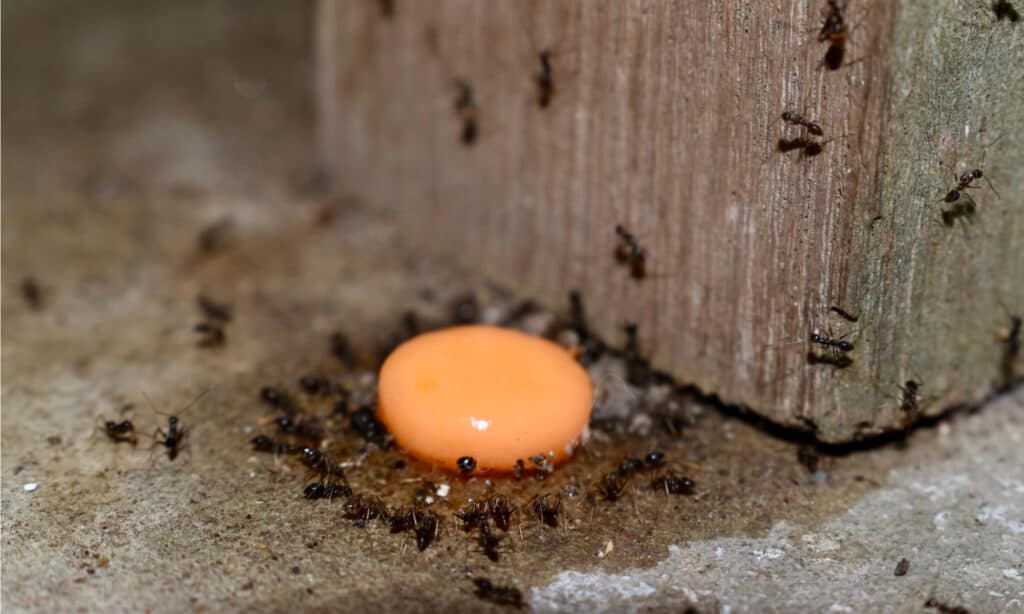
Regarding size, ants are the strongest animals in the world. They can lift objects 10-100 times heavier than their body weight.
©Zay Nyi Nyi/Shutterstock.com
- Ants are eusocial invertebrates belonging to the family Formicidae. Together with wasps and bees, ants belong to the order Hymenoptera of the class insect.
- Wasps are said to have evolved from wasp-like ancestors about 100 million years ago.
- There are over 12,000 ant species worldwide. Some common species include the bullet ant, carpenter ant, black garden ant, Argentine ant, banded sugar ant, honeypot ant, and fire ant.
- Most ant species live in the soil and cavities of plants and wood. Ants live in colonies of about 1000 insects.
- The diet of ants is made mainly of leaves, fungi, and other insects.
- Regarding size, ants are the strongest animals in the world. They can lift objects 10-100 times heavier than their body weight. Ants have a larger muscle-to-body ratio than humans. To put this into perspective, the Asian weaver ant can lift 100 times its weight.
- They are also the longest-living insects.
- Ants are highly intelligent and can solve problems, count their steps, and quickly navigate using their memories. They can also learn from each other and change their behavior based on previous experiences.
- Ants often ‘kidnap’ other ants from colonies nearby and enslave them, forcing them to work for them.
- Ants can be found in every region and continent except for the polar regions like the Arctic and Antarctica.
- The most gigantic ant species ever existed is a prehistoric ant called Titanomyrma Giganteum. It had a wingspan of six inches.
- The tiniest known ant is the tiny worker of the species Carebara Bruni. This minute organism is only eight-tenths of a millimeter long.
The Remarkable World of Ants
Ants are fascinating creatures with unique behavior and remarkable abilities. They play a vital role in the ecosystem and contribute to the health and balance of our ecosystem. These tiny wonders deserve our admiration and respect. While there is no need for a king ant in the ant kingdom, their collective intelligence and communication skills make them one of the most organized and successful societies in the natural world. Without a doubt, ants remain one of the most remarkable creatures on Earth.
Thank you for reading! Have some feedback for us? Contact the AZ Animals editorial team.

